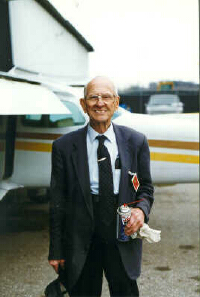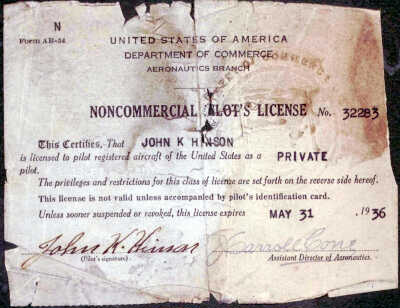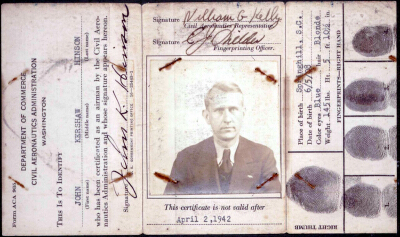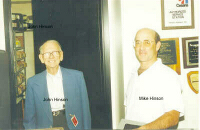

JOHN KERSHAW HINSON
By Clayton Davis Born in 1908 near Sumter, South Carolina, John K. Hinson migrated north to Washington. Having only a sixth grade education, but mechanically gifted, he found a job repairing motorcycles for the D.C. police department. Later, he sold automobiles. Hinson entered aviation in the 1930s when he learned to fly in one lesson at a cost of $45.The tradename Hinson carries with it a loyal following of former customers and employees. In the state of Maryland many pilots can make the claim they flew with John K. Hinson, flew for him, or were taught to fly by him.
Hinson's principles have never changed, fix it right the first time, sell a good product, and pay your bills on time. Every profession has one like John K. Hinson, put there to keep fools from breaking things. I personally never flew with anyone else who truly became part of the airplane when he laid hands on the controls. His senses seemed to travel out through the mechanical linkages to become one with the rivets, skin and paint.
If you asked him why the airplane performed so much better under his hands, his answer was a modest smile and the words, "Guess it's known me longer."
John K. Hinson knew more about reciprocating engines than the people who designed them. He could start an engine when nobody else could, no matter how cold the weather was. And his engines always had fresh oil in them.
He would smile and say, "Boss, you might be able to fly without much gas. But always keep oil in them."
Twenty years, off and on, I instructed for John K. Hinson's flying school, and flew air charter for him. Not once did I ever find one of his airplanes dirty. They were always serviced with fuel and oil, usually by him personally. Some pilots thought he opened the airport, woke up the rooster and ordered it to crow, then brought up the morning sun. John K. Hinson was always on the ramp long before his crews finished shaving and eating breakfast.
He told the story about selling an airplane to a farmer. He was flying along, way back in the hills, and looked down. A farmer down there had stopped his tractor and stood waving his hat up at the sky. John landed the bright yellow Piper Cub in the field. The farmer walked over and said he always wanted to fly one of those things.
John taught him to fly it in three hours. Then the farmer asked the price, went in his house and brought out cash money and paid for it.
John said, "There I stood. I had no way home. Had to start walking down out of the hills."


He was operating Rutherford Field when World War Two started. Rutherford and all Baltimore airports are described in the November 1941 issue of Baltimore Magazine, which published a special issue to honor the opening of Harbor Field as Baltimore Municipal Airport.
Rutherford Field was incorporated in November 1929 on 135 acres of land near Hebbville, between the Old Windsor Mill and Rolling Roads, and began operating May 1, 1930. The Baltimore Magazine article listed Rutherford Field as being operated by the Hinson Aeronautic Corporation, John K. Hinson as manager.
During World War Two, Hinson ferried airplanes all around the world for the Army Air Corps, all kinds, all sizes. And he was very effective in training aviators. For example, he recounted how pilots did not like the Curtiss C-46 Commando. They were being used to fly "The Hump", carrying goods over the Himalaya mountains from India to China.
Hinson said pilots were having trouble landing the C-46. He told me this when I was working on my Airline Transport Pilot certificate at Hinson Airways flight school, trying to understand V1, V2, Vr and Vref speeds. Way back then, during World War Two, nobody had any idea that speed control played an important part in takeoff and landing.
Today everyone knows airspeed control is vitally important. Hinson taught C-46 pilots how aircraft weight, runway length and condition all require different takeoff and landing speeds. Pilots caught on quickly and the C-46 became a beloved workhorse over "The Hump".
After the war Hinson operated at Harbor Field, making $2 million annually. His flying school had a contract with the Pentagon to give instrument flight training to U.S. Army pilots.
Hinson is listed in advertisements in aviation magazines in 1954 as a distributor for Met-Co-Aire in the Maryland, New Jersey, Pennsylvania, and Virginia region. It was a California company that replaced the fabric covering on Stinson airplanes with all-metal skin. At that time Stinson was considered a luxury single-engine airplane and owners swore by them.
John K. Hinson was the first pilot to land at the new Friendship International Airport, and the first to takeoff from it. He was the driving force responsible for building the South Ramp a growing commercial area along the road bordering the south edge of BWI.
Hinson Aviation Company was a Piper Aircraft dealership on the South Ramp and grossed about $1.9 million in 1963. The next year he retired and sold the company, but soon grew nervous from being idle. A few months later he was back in business, this time as Hinson Airways with offices in the main terminal at Friendship International Airport.

John K. Hinson's deep feeling for humanity was demonstrated one frigid winter day when he put skis on his Piper Cub and landed on Tangier island. A small boy's appendix had ruptured. Tangier island was locked in by ice. No boats could move. Hinson's airplane was the only way to reach the island. He flew the patient to Johns Hopkins Hospital. Forty years later the man came back and shook Hinson's hand and thanked him for saving his life.
An authentic aviation pioneer, John Kershaw Hinson influenced my life greatly, both as a pilot and a gentleman with enormous grace and dignity. Once or twice in your lengthy days you may be privileged to know and work for such a giant of a man.
* * *
HISTORY
1908 Born June 6, Sumter, South Carolina.
1920s Auto mechanic at Washington, D.C. police department. Soon had his own repair shop and show room. Was a dealership for Graham Paige and Hudson automobiles.
1930s Learned to fly. Repaired and sold airplanes at College Park and Queens Chapel airports. Was a Piper distributor. Was issued Commercial License number 32283
1940 Operated Rutherford Field until the war began.
1942 In World War II entered Army Air Corps Ferry Command as a Second Lieutenant. Was 16th person to join that Command and was issued ID card number 16 on January 13, 1942. Made historical contribution training aircrews.
1945 War ended. Left service with rank of Major.
1947 Rutherford Field was being operated by somebody else. Went to Lee airport, Annapolis, Maryland as a Piper dealer. Hangar burned down and he moved to Harbor Field, Baltimore.
1953 Operated large flying school at Hangar 4, Harbor Field. Contracted by U.S. Army Aviation to provide instrument training to their pilots, using 3 Link Trainers, 4 Stinson 108s and 10 Cessna 182s.
1960 Moved operation to South Ramp at Friendship Airport.
1963 Sold South Ramp business and retired for a few months.
1964 Went back into business as a Cessna dealer at Essex Field, Baltimore.
1966 Moved his operation back to Friendship (BWI) into the main terminal.
1973 Moved out of main terminal to small building nearby that was shared with the FAA.
1995 Sold business after falling and breaking his arm. His old charter customers continued to fly with grandson Michael Hinson's air charter company.
* * *


 RETURN TO MAIN PAGE
RETURN TO MAIN PAGE